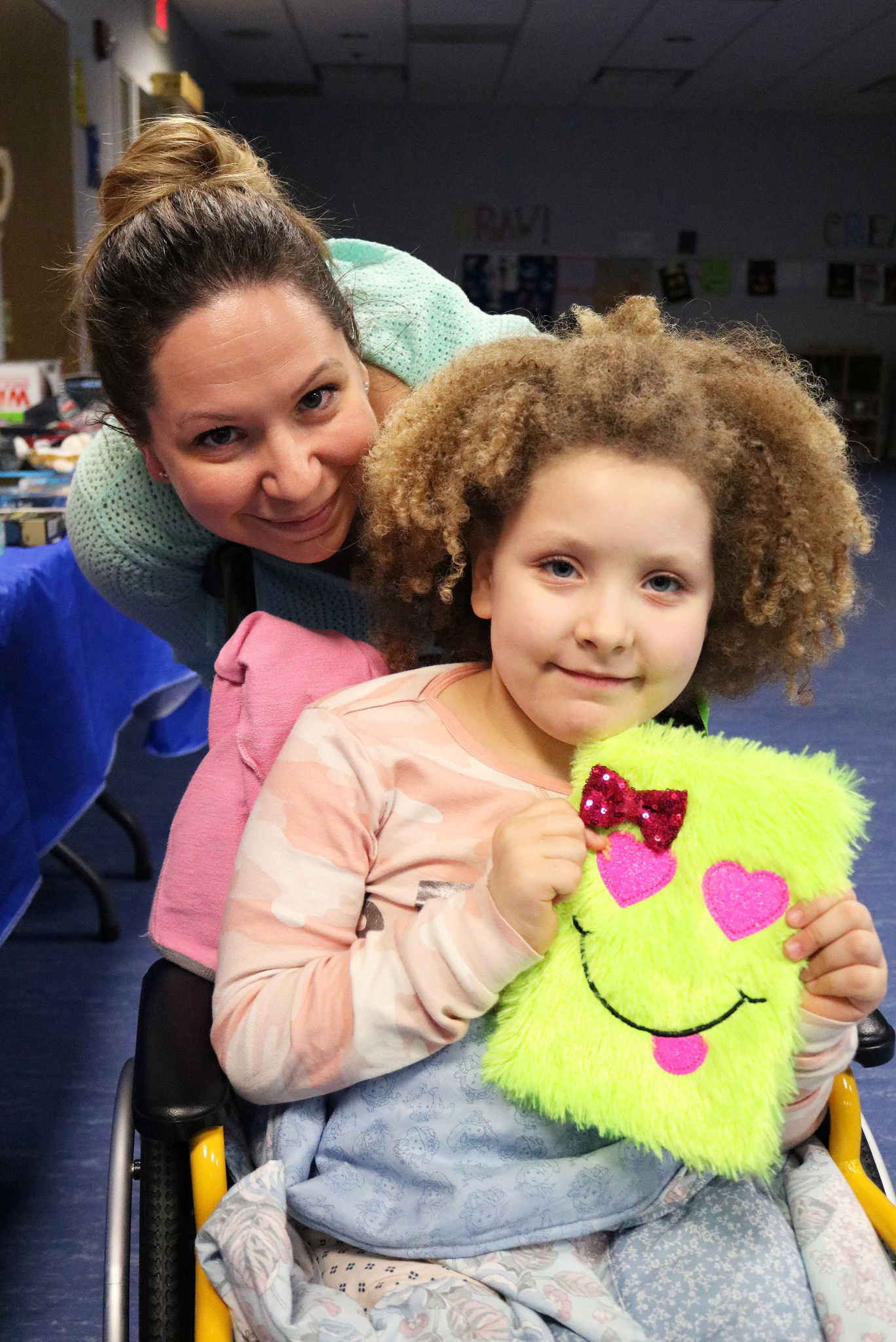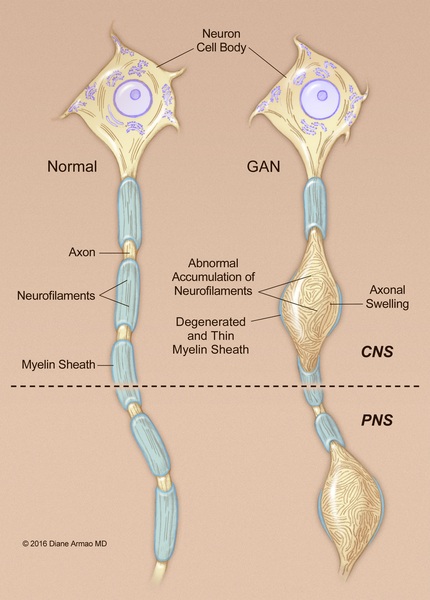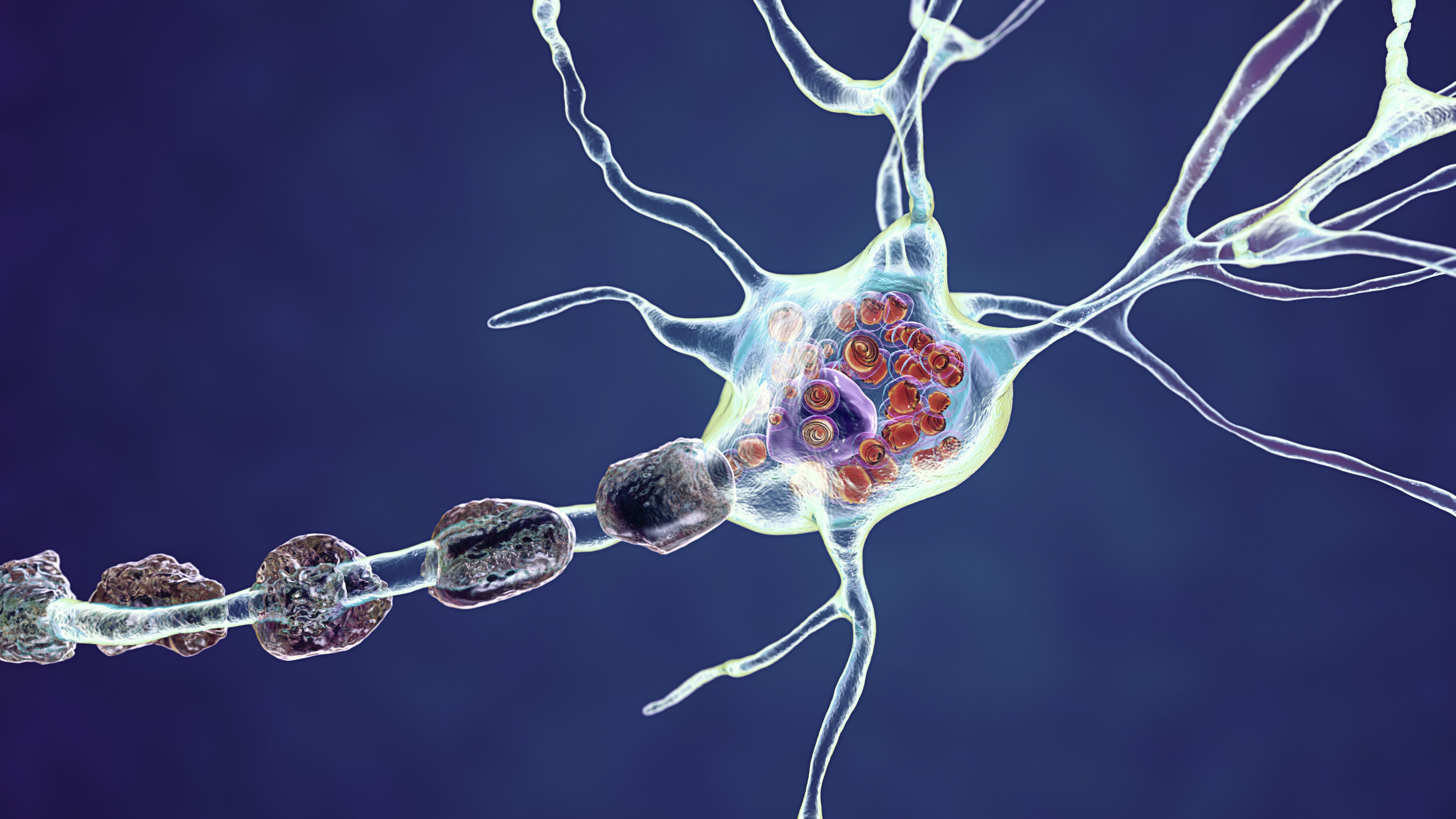Noteworthy articles on Giant Axonal Neuropathy
These articles and papers may help you better understand Giant Axonal Neuropathy, also known as GAN:
What is Giant Axonal Neuropathy?
From the National Institute of Health:
Giant axonal neuropathy (GAN) is a rare inherited disorder that affects the peripheral and central nervous system. The peripheral nervous system sends signals that control movement and sensation between the central nervous system (the brain and spinal cord) and all other parts of the body. (Click the article title or the image to read more.)
Giant Axonal Neuropathy
From Brainfacts.org:
Giant axonal neuropathy (GAN) is a rare inherited genetic disorder that affects both the central and peripheral nervous systems. The majority of children with GAN will begin to show symptoms of the disease sometime before five years of age. Signs of GAN usually begin in the peripheral nervous system, which controls movement and sensation in the arms, legs, and other parts of the body. The typical symptoms of GAN are clumsiness and muscle weakness that progresses from a “waddling gait” to a pronounced difficulty in walking. Additional symptoms include numbness or lack of feeling in the arms and legs, seizures, nystagmus (rapid back and forth movement of the eyes), and impaired cognitive development. A characteristic sign of the disease is dull, tightly curled hair that is markedly different from the parents’ in color and texture. (Click the article title or the image to read more.)
Giant Axonal Neuropathy
From MedlinePlus:
Giant axonal neuropathy is an inherited condition characterized by abnormally large and dysfunctional axons called giant axons. Axons are specialized extensions of nerve cells (neurons) that transmit nerve impulses. Symptoms of the disorder first become apparent in the peripheral nervous system, in which long axons connect the brain and spinal cord (central nervous system) to muscles and to sensory cells that detect sensations such as touch, pain, heat, and sound. However, axons in the central nervous system are affected as well. (Click the article title or the image to read more.)
Giant Axonal Neuropathy – Symptoms, Causes, Treatment
From RareDiseases.org:
Giant axonal neuropathy is a rare neuropathy that severely affects the peripheral as well as the central nervous system. The first symptoms appear in early childhood. This disorder is characterized by abnormalities in the peripheral and central nervous systems including low muscle tone (hypotonia), muscle weakness, decreased reflexes, impaired muscle coordination (ataxia), seizures and intellectual disability. Pale, tightly curled hair is frequently seen in those affected. Giant axonal neuropathy follows autosomal recessive genetic inheritance. (Click the article title or the image to read more.)
Giant Axonal Neuropathy: Clinical, Radiological, and Genetic Features
From the National Library of Medicine:
Giant axonal neuropathy (GAN) is an inherited neurodegenerative disorder caused by mutations in the GAN gene. It affects both the central and peripheral nervous systems. We discuss clinical, electrophysiological, radiological and genetic features in three new unrelated patients with GAN. (Click the article title or the image to read more.)
Giant Axonal Neuropathy
From the portal for rare diseases and orphan drugs:
Giant axonal neuropathy (GAN) is a severe, slowly progressive neurodegenerative disorder characterized by progressive motor and sensory peripheral neuropathy, central nervous system involvement (including pyramidal and cerebellar signs), and characteristic kinky hair in most cases…The prevalence is unknown, but to date approximately 50 families have been reported. The frequency of this disease however, is likely to be underestimated, due to patients with incomplete phenotypes and high level of consanguinity among some populations. It occurs equally in both sexes. (Click the article title or the image to read more.)
Giant Axonal Neuropathy: Everything You Need to Know
From Healthline:
This rare genetic disorder may affect fewer than 100 people worldwide. You may experience difficulty walking or numbness in your arms and legs at first, but it can develop into more serious symptoms.
Giant axonal neuropathy (GAN) is a very rare, inherited disorder. It affects your nerve cells. After a while, it affects your entire nervous system.
You may experience difficulty walking or numbness in your arms and legs at first, but it can progress into more severe symptoms that include difficulty breathing, seizures, or paralysis.
People usually begin to have symptoms by 5 years old. Some people with a milder form may begin to have symptoms at later ages.
Here’s what to know about GAN, including symptoms to look for and possible outcomes. (Click the article title or the image to read more.)
What is Giant Axonal Neuropathy?
From Charcot-Marie-Tooth Association:
Giant axonal neuropathy (GAN) is a rare inherited genetic disorder that affects both the central and peripheral nervous systems.
Researchers have discovered more than 20 different mutations associated with GAN in a gene, GAN1, which makes a protein called gigaxonin. These mutations disrupt the regulation or production of gigaxonin in the nervous system. As a result, axons, which are the long tails of neurons that allow them to communicate with other nerve cells, swell up with tangled filaments and become abnormally large. Eventually these axons deteriorate and cause problems with movement and sensation since neurons are no longer able to communicate with each other. (Click the article title or the image to read more.)
Handbook of Clinical Neurology – Giant axonal neuropathy
From ScienceDirect.com:
Abstract
Giant axonal neuropathy (GAN) is a rare hereditary autosomal recessive neurodegenerative disease affecting both the peripheral and the central nervous system. Clinically it is characterized by an age of onset during the first decade, progressive and severe motor sensory neuropathy followed, in some patients, by the occurrence of various central nervous system signs such as cerebellar syndrome, upper motor neuron signs, or epilepsy. Although kinky hairs are reported in the majority of patients, it is not a constant finding. The prognosis is usually severe with death occurring during the second or third decade; nevertheless a less severe course is reported in some patients. The presence of a variable number of giant axons filled with neurofilaments in the nerve biopsy represents the pathological feature of the disease and it is usually associated to a variable degree with axonal loss and demyelization. Giant axons are also found in the central nervous system associated with Rosenthal fibers and a variable degree of involvement of white matter and neuronal loss. The disease is caused by mutation in the GAN gene encoding for gigaxonin, a member of BTB-Kelch. Up to now 37 mutations in the GAN gene have been reported. These mutations are scattered over the 11 exons of the gene without a clear genotype–phenotype correlation. These mutations resulting in gigaxonin deficiency lead to a slow down in ubiquitin-mediated protein degradation and possibly of other unidentified proteins. GAN represents a good model of a neurodegenerative disorder in which there is a primary defect of the ubiquitin proteasome system and its network with neurofilaments. The clarification of molecular mechanisms involved in GAN can help in understanding other frequent neurodegenerative diseases such as amyotrophic lateral sclerosis (ALS) and Parkinson disease. (Click the article title or the image to read more.)







